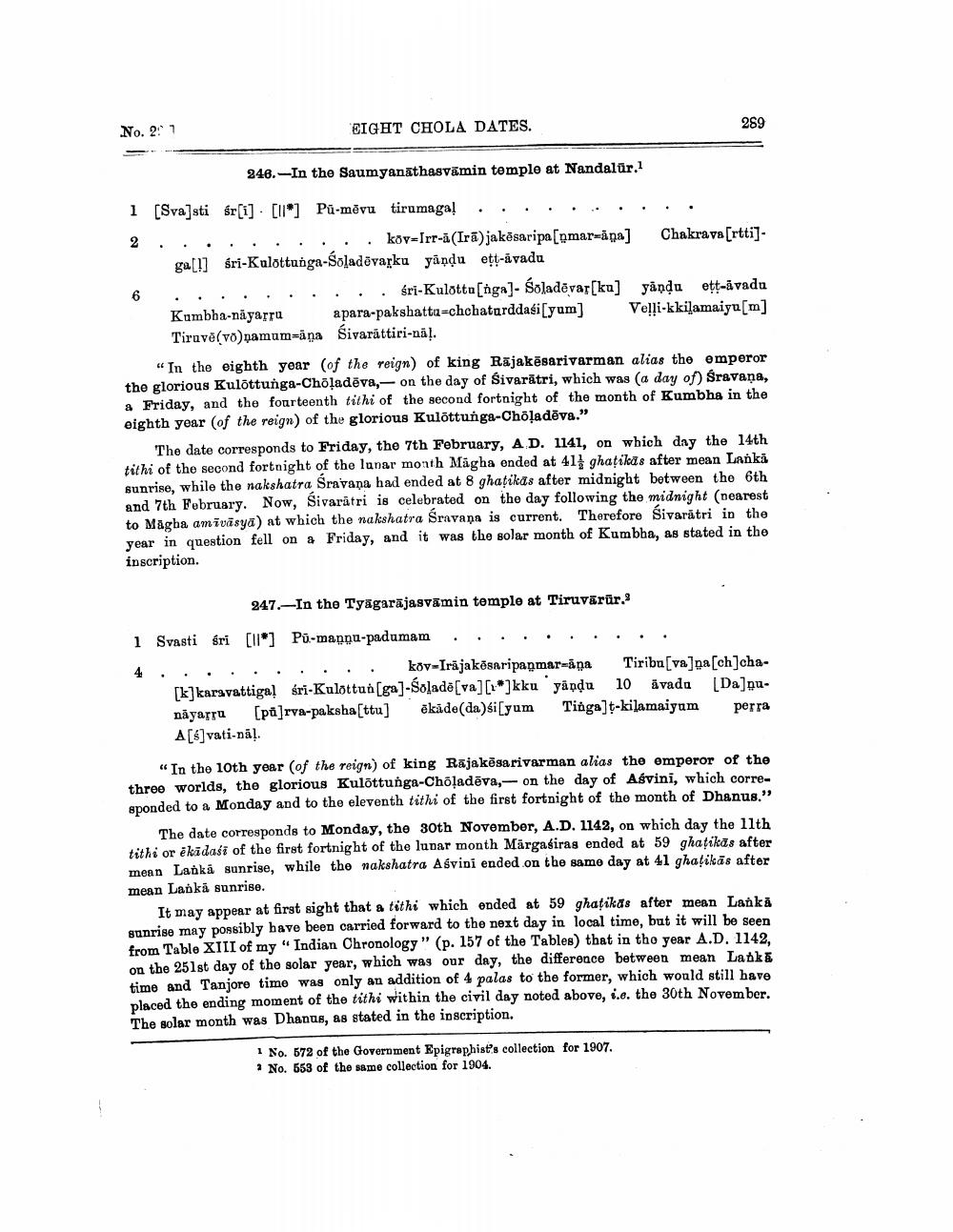________________
No. 27
EIGHT CHOLA DATES.
246. In the Saumyanathasvāmin temple at Nandalür.1
1 [Sva]sti śr[i] [ll] Pů-mēvu tirumaga! .......... 2 . .kov=Irr-(Irā)jakësaripa[nmar=āņa] Chakrava[rtti]
ga[!] Sri-Kulottunga-Soladēvarku yandu ett-ivadu .. ...
sri-Kulotto[nga]- Soladēvar[ku] yandu ett-āvada Kumbha-näyarra apara-pakshatta=chchatarddasi yum] Velļi-kkilamaiyu[m]
Tiravě(vo)namum=āņa Śivarättiri-nä!.
"In the eighth year of the reign) of king Rajakēsarivarman alias the emperor the glorious Kulõttunga-Chöļadēva, - on the day of Sivarātri, which was (a day of) Śravana, a Friday, and the fourteenth tithi of the second fortnight of the month of Kumbha in the eighth year of the reign) of the glorious Kulöttunga-Chöļadēva."
The date corresponds to Friday, the 7th February, AD. 1141, on which day the 14th tithi of the second fortnight of the lunar month Magha ended at 411 ghatikas after mean Lanka sunrise, while the nakshatra Sravana had ended at 8 ghatikas after midnight between the 6th and 7th February. Now, Sivaratri is celebrated on the day following the midnight (nearest to Mägba amīvāsya) at which the nakshatra Sravana is current. Therefore Sivaratri in the year in question fell on Friday, and it was the solar month of Kumbha, as stated in the inscription.
247.-In tho Tyagarajasvāmin templo at Tiruvarur.
1 Svasti śri [ll*] Pu-mappu-padumam .......... 4 . . . . . . . . kov-Irājakēsaripapmar-ana Tiribusvalnasch lcha
[k]karavattiga! sri-Kulottun [ga]-Soladēsva][*]kku yaņdu 10 avada [Da]ņunäyarru (pā]rva-paksha(ttu] ēkāde(da)śi[yum Tinga]t-kilamaiyum perra A[s]vati-nā!
“In the 10th year of the reign) of king Rājakēsarivarman alias the emperor of the three worlds, the glorious Kulõttunga-Choladēva,- on the day of Asvini, which corregponded to a Monday and to the eleventh tithi of the first fortnight of the month of Dhanus."
The date corresponds to Monday, the 30th November, A.D. 1142, on which day the 11th tithi or ēkādasi of the first fortnight of the lunar month Märgasiras ended at 59 ghatikās after mean Lanka sunrise, while the nakshatra Asvini ended on the same day at 41 ghaçikās after mean Lanki sunrise.
It may appear at first sight that a tithi which ended at 59 ghatikas after mean Lanka sunrise may possibly have been carried forward to the next day in local time, but it will be seen from Table XIII of my "Indian Chronology" (p. 157 of the Tables) that in tho year A.D. 1142, on the 251st day of the solar year, which was our day, the difference between mean Lanka time and Tanjore time was only an addition of 4 palas to the former, which would still have placed the ending moment of the tithi within the civil day noted above, i.e. the 30th November. The solar month was Dhanus, as stated in the inscription.
1 No. 572 of the Government Epigraphist's collection for 1907. * No. 553 of the same collection for 1904.




